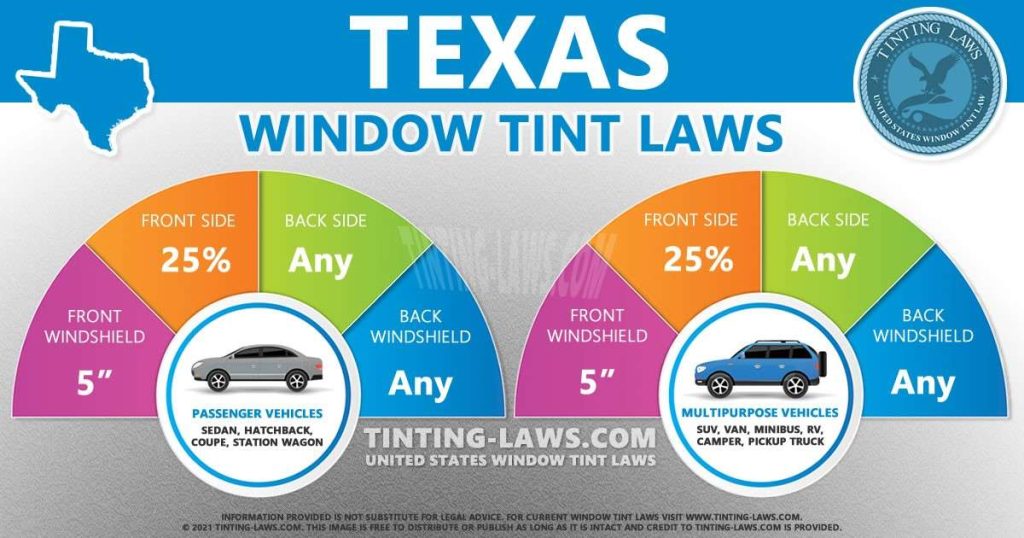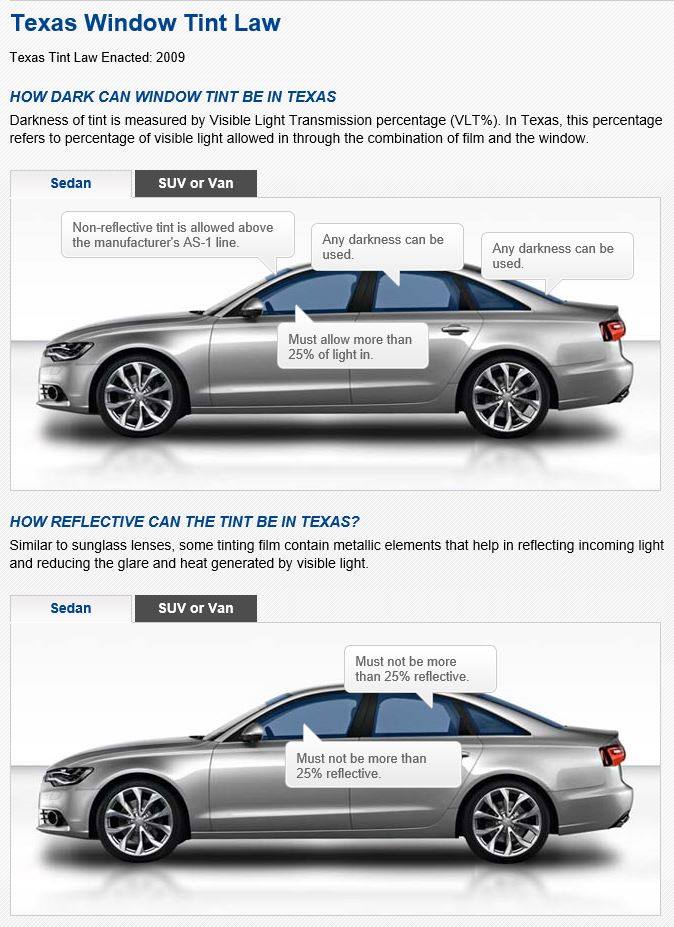As an Amazon Associate, I earn from qualifying purchases
Tinting your car windows in Texas? You need to know the rules.
Texas has specific laws about car window tinting. The Texas car tint law aims to balance driver comfort and road safety. These laws regulate how dark your car windows can be. Violating these rules can result in fines. Knowing these regulations helps you avoid trouble.
The law is designed to ensure that drivers have clear visibility while driving. Understanding this law is crucial for car owners in Texas. Whether you’re looking to add privacy or reduce heat, staying within legal limits is key. In this blog, we’ll break down the Texas car tint law. This will help you make informed decisions about your car’s window tint. Stay tuned to learn everything you need to know!

Credit: www.tinting-laws.com
Introduction To Texas Car Tint Law
Understanding the Texas Car Tint Law can be crucial. This law governs how dark or reflective your car windows can be. Knowing the rules helps you avoid fines and ensures safe driving conditions. Let’s dive into why these laws exist and their history.
Purpose Of Tint Laws
Car tint laws protect drivers and passengers. They ensure visibility is not hindered. Proper visibility reduces accidents. Tint laws also aid law enforcement. Officers need to see inside vehicles during traffic stops. This ensures their safety and yours.
Historical Background
Car tint laws have evolved over the years. Initially, there were no regulations. Increased use of tinted windows led to visibility concerns. States then began to create laws. Texas introduced its first tint laws in the 1980s. These laws aimed to balance style and safety. Over time, adjustments were made. The goal remained clear: ensure safe driving conditions.

Credit: sunbusterstint.com
Legal Tint Percentages
Understanding the legal tint percentages in Texas is important. Car window tinting laws vary by state. In Texas, the rules ensure safety and visibility for all drivers. Each window has specific rules. This helps maintain a clear vision for drivers and law enforcement.
Windshield Tint Limits
The windshield can only have a strip of tint. This strip must be above the AS-1 line. The AS-1 line is a mark on most windshields. This strip can be up to five inches. The tint must allow at least 25% of light through.
Front Side Windows Regulations
Front-side windows must allow more light. Texas law requires at least 25% of light to pass through. This helps drivers see clearly. It also allows law enforcement to see inside the vehicle.
Back Side Windows And Rear Window Rules
Backside windows and the rear window have different rules. These windows can be darker. They must allow at least 25% of light through. This is the same as the front side windows. However, if the vehicle has side mirrors, a darker tint is allowed. The side mirrors must provide a clear view of the road behind.
Exceptions And Exemptions
Texas car tint laws are strict but have some exceptions and exemptions. These special cases allow certain vehicles or individuals to have darker tints. Let’s explore these exceptions and exemptions.
Medical Exemptions
Some medical conditions make individuals sensitive to sunlight. People with such conditions can get medical exemptions. A doctor must provide a signed statement. This statement allows them to use darker tints on their vehicles. The exemption helps protect their health while driving.
Commercial Vehicle Regulations
Commercial vehicles follow different tint rules. These rules ensure safety and visibility on the road. For example, taxis and buses often have specific tint requirements. The regulations help passengers feel safe and comfortable. They also ensure drivers have clear visibility, reducing accidents.
Penalties For Non-compliance
Understanding the Texas Car Tint Law is crucial for vehicle owners. Failing to comply with these regulations can lead to serious consequences. These penalties range from monetary fines to affecting your vehicle inspection. Below, we will explore the main penalties associated with non-compliance.
Fines And Citations
Non-compliance with car tint laws can result in fines and citations. The severity of these fines depends on the level of the violation. Here’s a breakdown of what you might face:
| Violation Level | Fine Amount |
|---|---|
| First Offense | $20 – $100 |
| Second Offense | $100 – $200 |
| Subsequent Offenses | $200 – $500 |
Receiving multiple citations can also affect your driving record. This can lead to increased insurance premiums. It’s essential to comply with the Texas Car Tint Law to avoid these penalties.
Impact On Vehicle Inspection
Non-compliant tint can also impact your vehicle inspection. In Texas, cars must pass an annual safety inspection. If your tint is too dark or reflective, you will fail this inspection. This means you cannot legally drive your car until the issue is fixed.
Below is what you need to know about vehicle inspections:
- Inspectors check the Visible Light Transmission (VLT) percentage.
- Front-side windows must allow more than 25% of light in.
- Rear windows have more relaxed rules, but still must be checked.
Failing the inspection means you will need to remove or replace the tint. This can be costly and time-consuming. Always ensure your tint complies with Texas laws to avoid inspection issues.
Benefits Of Legal Tinting
Legal tinting on car windows offers several benefits that enhance driving comfort and safety. These benefits go beyond aesthetics, providing practical advantages. Let’s explore the key benefits of legal car tinting in Texas.
Heat Reduction
Legal tinting helps reduce the heat inside your car. It blocks a significant amount of solar energy. This keeps the interior cooler, especially during hot Texas summers. A cooler car means less reliance on air conditioning. This can lead to fuel savings and increased comfort during long drives.
Uv Protection
Legal tints protect against harmful UV rays. UV rays can cause skin damage and contribute to aging. They can also fade and damage your car’s interior. Tinted windows block up to 99% of UV radiation. This helps protect your skin and preserve your car’s upholstery, dashboard, and other interior components.
Enhanced Privacy
Tinted windows offer increased privacy. They make it harder for people to see inside your car. This can be helpful when you leave valuables in your car. It also provides a sense of security and comfort for you and your passengers. Legal tints ensure you stay within the law while enjoying these privacy benefits.
Choosing The Right Tint
Choosing the right tint for your car can be challenging. The Texas car tint law is strict. You need to balance legal requirements with your personal preferences. Understanding the different types of tint films and the choice between professional and DIY tinting can help you make an informed decision.
Types Of Tint Films
There are several types of tint films available. Each type offers unique benefits and limitations. Here’s a brief overview:
| Type | Benefits | Limitations |
|---|---|---|
| Dyed Tint Film | Affordable, reduces glare | Fades over time, less effective at heat reduction |
| Metalized Tint Film | Durable, good heat reduction | Interferes with electronics, more expensive |
| Carbon Tint Film | Blocks UV rays, does not fade | More expensive |
| Ceramic Tint Film | Excellent heat reduction, no signal interference | Most expensive |
Professional Vs Diy Tinting
Deciding between professional and DIY tinting is crucial. Both options have their pros and cons.
Professional Tinting:
- High-quality installation
- Warranty provided
- Expensive
DIY Tinting:
- Cost-effective
- Flexible timing
- Risk of poor installation
If you value quality and longevity, professional tinting is often the best choice. If you prefer a budget-friendly option and have some DIY skills, DIY tinting could work for you.
How To Check Tint Compliance
Ensuring your car’s window tint complies with Texas law is important. Non-compliance can lead to fines and legal issues. Here’s how to check if your tint meets legal requirements.
Using A Tint Meter
A tint meter is a handy tool. It measures the darkness of your car’s window tint. You can buy or rent one. Place the meter on your window. It will give a reading of the Visible Light Transmission (VLT) percentage.
Texas law requires the front side windows to have a VLT of at least 25%. The rear side windows can be darker. Ensure your tint meter is calibrated. This guarantees an accurate reading. If your window tint is too dark, it needs adjusting.
Consulting Professionals
Not everyone has a tint meter. Consulting a professional is another option. Many car shops offer tint inspection services. They have the right tools and knowledge.
Professionals ensure your tint complies with the law. They can also adjust it if necessary. This saves you time and ensures accuracy. Choose a reputable shop. Check their reviews and ratings before making a decision.

Credit: frontporchnewstexas.com
Future Of Tint Laws In Texas
The future of tint laws in Texas is a topic of great interest for many drivers. As technology and safety standards evolve, the regulations surrounding car window tinting are also likely to change. Understanding these potential changes and the advocacy efforts behind them can help car owners stay informed.
Potential Changes
In the coming years, Texas may introduce new tint regulations to address advancements in window tint technology. For example:
- Adjustments to the allowable Visible Light Transmission (VLT) percentages.
- New rules for reflective tints.
- Stricter guidelines for medical exemptions.
These changes aim to enhance driver safety and ensure that law enforcement can effectively perform their duties. Many believe that as tint technology improves, the laws will need to adapt to remain relevant and effective.
Advocacy And Legislation
Various advocacy groups and lawmakers are actively involved in shaping the future of tint laws in Texas. Their efforts focus on:
- Raising public awareness about the benefits and risks of window tinting.
- Proposing new bills and amendments to existing laws.
- Collaborating with industry experts and law enforcement to develop balanced regulations.
These groups often hold public forums and meetings to gather input from the community. By staying informed and participating in these discussions, drivers can have a say in the laws that affect their vehicles.
As the landscape of tint laws continues to evolve, staying up-to-date with the latest developments is crucial for all Texas drivers.
Frequently Asked Questions
What Is The Legal Tint Limit In Texas?
In Texas, the front windshield can have a tint strip above the AS-1 line. The front side windows must allow more than 25% of light in.
Are There Medical Exemptions For Car Tint In Texas?
Yes, Texas allows medical exemptions for darker tints if you have a medical condition that requires it. You must carry a doctor’s certificate.
Can I Tint My Car’s Rear Windows?
Yes, in Texas, you can tint your rear side windows and rear windshield as dark as you like.
What Are The Penalties For Illegal Tint In Texas?
Penalties for illegal tint in Texas can include fines and the requirement to remove the tint. Fines can range from $20 to $275.
Conclusion
Understanding Texas car tint laws helps you stay compliant and avoid fines. Always check the latest regulations before tinting your windows. This ensures safety and legal driving. Remember, proper tinting enhances your car’s appearance and comfort. Keep these guidelines in mind for a hassle-free experience.
Stay informed, drive safely, and enjoy your tinted windows responsibly.
As an Amazon Associate, I earn from qualifying purchases


